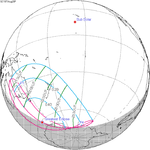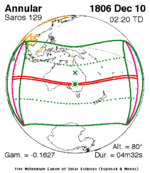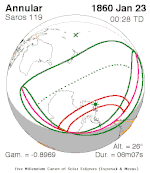| Annular eclipse | |
| Gamma | −0.2704 |
|---|---|
| Magnitude | 0.9954 |
| Maximum eclipse | |
| Duration | 26 s (0 min 26 s) |
| Coordinates | 14°48′S116°18′E / 14.8°S 116.3°E |
| Max. width of band | 16 km (9.9 mi) |
| Times (UTC) | |
| Greatest eclipse | 4:54:57 |
| References | |
| Saros | 129 (49 of 80) |
| Catalog # (SE5000) | 9440 |
An annular solar eclipse occurred at the Moon's ascending node of orbit on Tuesday, March 18, 1969, [1] with a magnitude of 0.9954. A solar eclipse occurs when the Moon passes between Earth and the Sun, thereby totally or partly obscuring the image of the Sun for a viewer on Earth. An annular solar eclipse occurs when the Moon's apparent diameter is smaller than the Sun's, blocking most of the Sun's light and causing the Sun to look like an annulus (ring). An annular eclipse appears as a partial eclipse over a region of the Earth thousands of kilometres wide. The Moon's apparent diameter was near the average diameter because it occurred 5.1 days after perigee (on March 13, 1969, at 2:50 UTC) and 7.7 days before apogee (on March 25, 1969, at 19:30 UTC). [2]
Contents
- Eclipse details
- Eclipse season
- Related eclipses
- Eclipses in 1969
- Metonic
- Tzolkinex
- Half-Saros
- Tritos
- Solar Saros 129
- Inex
- Triad
- Solar eclipses of 1968–1971
- Saros 129
- Metonic series
- Tritos series
- Inex series
- Notes
- References
Annularity was visible from part of Indonesia, and two atolls (Faraulep and Gaferut) in the Trust Territory of the Pacific Islands which belongs to the Federated States of Micronesia now. A partial eclipse was visible for parts of the Malagasy Republic (today's Madagascar), Antarctica, Australia, Southeast Asia, East Asia, and northern Oceania.









































































































